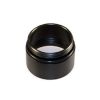YSI 1003A Amplified pH/ORP Sensor
Features
- Great than 2 years battery life, if store correctly
- Elimination of potentially erratic readings in high static environments
- Can be used with the YSI Professional Series line of handheld instruments
- Free ground shipping
- Expedited repair and warranty service
- Lifetime technical support
- More
Overview
The YSI 1003A pH and combination pH/ORP sensors have an internal, battery-powered pre-amplifier designed for use in difficult environments. The available extension adapter attaches to the bulkhead, so the longer sensors fit in the probe guard for the Pro1010 and Pro1020 cables (not needed on the Pro Plus Quatro cable). All YSI flow cells work normally with the YSI Professional Series line of handheld instruments.
Applications
- Improved sensitivity and stability in applications with very cold waters and for applications requiring long cable lengths
- Applications that require a long duration in the field where there is the potential for exposure of the connectors to moisture
- (1) YSI 1003A pH/ORP electrode
- (1) Storage bottle with solution
- (1) Instruction sheet
- (1) Cleaning certificate
In The News
Ocean acidification: University of Washington's giant plastic bags help control research conditions
With oceans becoming more acidic worldwide, scientists are getting creative in designing experiments to study them. For example, one group at the University of Washington is using giant plastic bags to study ocean acidification. Each bag holds about 3,000 liters of seawater and sits in a cylinder-like cage for stability. The group at UW, made up of professors and students, is controlling carbon dioxide levels in the bags over a nearly three-week period, during which they are looking at the effects of increased acidity on organisms living near the San Juan Islands. “These mesocosms are a way to do a traditional experiment you might do in a lab or classroom,” said Jim Murray, professor of oceanography at the University of Washington.
Read MoreNOAA Alaska buoy network to monitor North Pacific ocean acidification
National Oceanic and Atmospheric Administration scientists detected signs of ocean acidification in the waters that hold the vulnerable and valuable fisheries of the North Pacific off the coast of Alaska, but they only had a snapshot of the action. “We know that in this place were important commercial and subsistence fisheries that could be at risk from ocean acidification,” said Jeremy Mathis, a NOAA Pacific Marine Environmental Laboratory researcher and professor at the University of Alaska Fairbanks. To understand how ocean acidification affects the North Pacific, NOAA scientists created a mooring network that collects constant in situ data on parameters contributing to acidification. They hope it will reveal seasonal trends and patterns left out by their snapshots.
Read MoreThree Decades of Research at Acton Lake
A multi-disciplinary team at Miami University, Ohio, has been studying the environmental change at Acton Lake for over three decades. Using three different NexSens buoys over this time, the team has an incredible archive of data that is helping build a picture of Acton’s past, present, and future. Until recently, a NexSens CB-50 buoy was used alongside other environmental monitoring at Acton Lake. In May 2025, the Miami team deployed a new XB-200 buoy , future-proofing their ongoing monitoring using real-time buoy systems. Acton Lake, a small hypereutrophic reservoir in southwest Ohio, covers 2.4km² and has a maximum depth of about 8m. The dam was built in 1956, and the lake has a large agricultural watershed.
Read More








